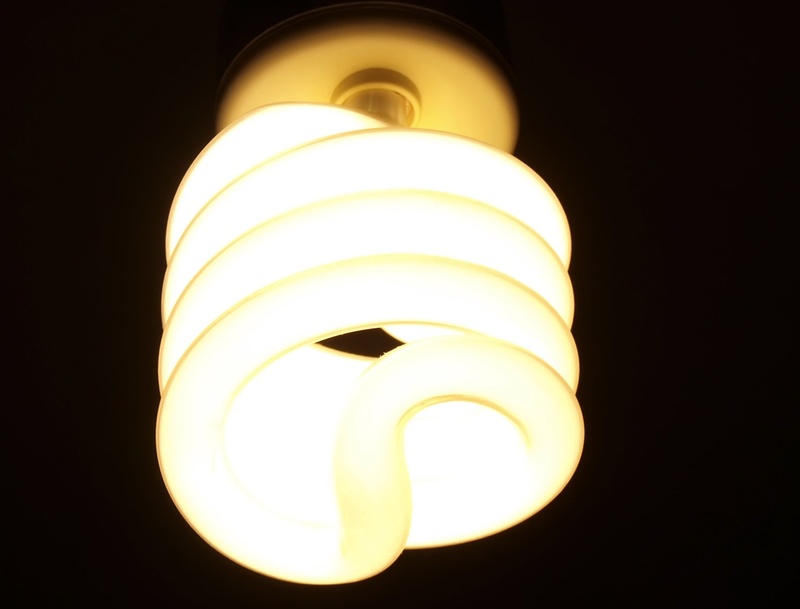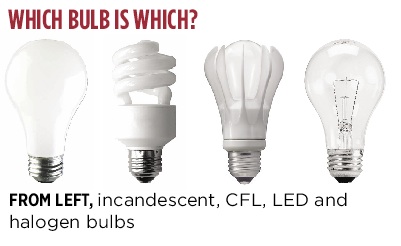Relax. Take a deep breath.
No, incandescent lightbulbs have not been banned, despite what certain radio talk shows may be telling you.
And no, the government is not going to force you to buy compact fluorescent (CFL) bulbs.
So why are some people hoarding incandescent bulbs? It all started with a federal law passed in 2007 that requires lightbulb manufacturers to improve the efficiency of incandescent bulbs.
Some more inefficient lightbulbs are being phased out, beginning with the 100-watt bulb last January. Then, according to the schedule of rolling deadlines, on Jan. 1, 2013, manufacturers will no longer be able to manufacture 75-watt bulbs. The final deadline is Jan. 1, 2014, when 60-watt and 40-watt bulbs as we know them will go dark.
The bulbs that have already been made will remain on store shelves until they are gone.
But, again, this does not mean incandescent bulbs have been banned. It just means manufacturers are now required to produce more efficient ones, like the halogen incandescent bulb that uses 28 percent less energy than its cousin. It looks just like the old 100-watt bulb, except instead of a filament inside, it has a little capsule that allows it to burn more efficiently.
The law exempts all kinds of bulbs, so you don’t have to worry about your refrigerator bulb, black lightbulb, bug lamp, infrared lamp, marine lamp, plant light, reflector bulb, three-way bulb or many other (more obscure) bulbs.
None of this is comforting to Michael Jubinsky, the owner of a baking school in Lyman. Jubinsky is one of the people stockpiling 60-, 75- and 100-watt lightbulbs in preparation for the time they disappear from store shelves. He thinks the whole issue is “all politics.”
“I know they say it saves energy,” he said. “What I have the real problem with is this whole thing was forced down our throats. There wasn’t a manufacturer in the United States that made compact fluorescents. They were all made in China. I think that may have changed — someone may be making them in the United States now — but for the longest time, they were all made in China, and you can’t just chuck them. They’ve got mercury in them. You’ve got to take them and dispose of them as a hazardous material.
“We’re just screwing with the little people again, the people who have no voice.”
Jubinsky estimates that he has about 50 packages of lightbulbs stored on a shelf in his basement. He finds them on sale or picks them up at Walmart.
“Every once in a while, one of the stores has them on sale, even supermarkets,” he said. “They’re trying to clear the shelves, apparently. I’ll see them on sale and pick up three or four packages of them.”
MANUFACTURERS ON BOARD
The transition to more energy-efficient bulbs is one environmentally friendly government mandate that manufacturers now support — they’ve been preparing for it since 2007 — but industry experts say there’s not a lot of understanding among the public about what the law actually says. Consumers worry they’ll be forced to pay more for a product they like less.
Joseph Higbee, spokesman for the National Electric Manufacturers Association in Rosslyn, Va., acknowledges that there have been lots of media reports of panicked consumers buying up 100-watt lightbulbs like they’re the last batch of snickerdoodles in a roomful of cookie monsters. He chalks it up to “a lot of misunderstanding and confusion.”
The more energy-efficient bulbs are indeed more expensive in the store, but prices are dropping, and manufacturers argue they will ultimately save consumers money over time.
“Costs up front are going down for some of the technologies,” Higbee said. “So up front you can pay less and buy more frequently, and pay a higher energy bill, or you can have a little higher up-front cost and save money over the long run. But a lot of times, people don’t think of the two costs involved. They think of one cost: Buying it.”
One lightbulb manufacturer, Bulbrite, did a side-by-side comparison and found that the halogen incandescent costs $2.50 per bulb, while the old 100-watt bulbs cost just 70 cents per bulb. The halogen bulb will save you $3.38 per year in energy costs, but it only has half the life of the old bulbs.
To really save money, you have to move to another alternative such as compact fluorescent bulbs. Those cost seven times more than a 100-watt bulb, but a $5 bulb will use about 78 percent less energy and save you $9.28 a year, according to Bulbrite.
An LED light is the most expensive, costing about $20 in this comparison. It uses 86 percent less energy, and saves $10.36 per year.
For a more personalized comparison, go to the Efficiency Maine website (efficiencymaine.com/at-home/residential-lighting-program), which has a savings calculator where consumers can plug in the wattage and number of bulbs they’re using, along with the number of hours a day the bulbs are on, and find out how much they’ll save with compact fluorescents.
DISPOSAL DOS AND DON’TS
What about Jubinsky’s point about the mercury in compact fluorescent bulbs?
Compact fluorescent bulbs do contain a small amount of mercury, which makes disposal an important issue. But Dylan Voorhees, clean energy and global warming project director for the Natural Resources Council of Maine, notes that the state has been a leader in addressing the problem with a free recycling program.
Consumers can recycle their bulbs for free at more than 100 retail stores in the state, as well as at many solid waste facilities. To find a recycling spot near you or learn how to properly clean up a broken bulb that contains mercury, go to lamprecycle.org/maine.shtml.
Voorhees says the new lighting standards are not unlike the federal energy efficiency standards for products like refrigerators, dishwashers and other appliances that consumers have embraced.
“Lighting is a huge portion of the use of electricity in this country,” Voorhees said, “and we never really had efficiency standards for lighting in the way that we’ve had for other appliances until just a few years ago. It’s a performance standard.”
For some people, it’s not the cost or environmental concerns at issue, but simply the light. People like the light from a 100-watt bulb and think they can’t get it anywhere else.
“A lot of times what happens is, people will select the technology at the store, they’ll take it home and screw it in, and they’ll say, ‘This is too blue, I hate this thing,’ ” Higbee said. ” ‘I don’t like this type of light.’ And really, that technology that they purchased could have been purchased in a yellowish-white, more of a softer white look, but they purchased the blue one.”
Jubinsky hates the light from compact fluorescent bulbs, and only has one in his house. He calls it his “token compliance” with the law.
“The CFL bulbs don’t give you the same amount of illumination, no matter what they tell you, as the incandescents do,” he said.
As an example, Jubinsky cited the light fixture in his dining room that uses one 60-watt incandescent bulb.
“I’ll put in a 60-watt equivalent compact fluorescent, and I’ve got to eat by the Braille method,” he said. “It’s like a freaking night-light. So I got rid of that and I put my 60-watt incandescent back in again.”
Even the “cool white ones,” he said, cast light with “a slight green cast to it.”
“Especially when you’re dealing with food,” Jubinsky said, “you don’t want your food to look like it’s got moss growing on it.”
Jubinsky said he had not tried the halogen incandescent bulbs yet.
Voorhees said it will take some time for the older products to get used up and consumers to make the switch. As that happens, costs will start to come down.
“The bottom line is, this is good for consumers,” Voorhees said. “People will save money on their energy bills as a result of this policy.”
It will take a lot to convince Jubinsky that the new policy is a good thing. But he says there will be limits to his hoarding. He’s building a storage shed at his home right now, and “I don’t want to have to build another one for lightbulbs,” he said, laughing. “People think I’m nuts enough.”
Staff Writer Meredith Goad can be contacted at 791-6332 or at:
mgoad@pressherald.com
Twitter: MeredithGoad
Send questions/comments to the editors.





Success. Please wait for the page to reload. If the page does not reload within 5 seconds, please refresh the page.
Enter your email and password to access comments.
Hi, to comment on stories you must . This profile is in addition to your subscription and website login.
Already have a commenting profile? .
Invalid username/password.
Please check your email to confirm and complete your registration.
Only subscribers are eligible to post comments. Please subscribe or login first for digital access. Here’s why.
Use the form below to reset your password. When you've submitted your account email, we will send an email with a reset code.